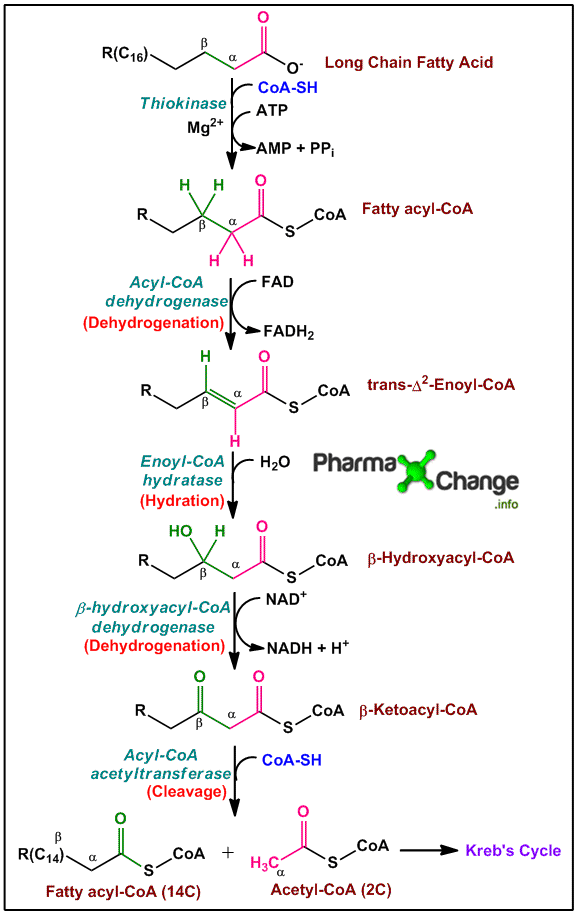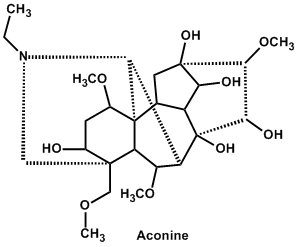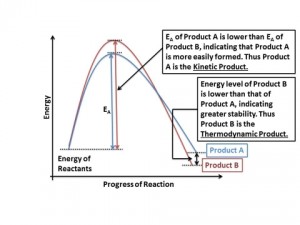Introduction
Triacylglycerols (fats) are the most abundant source of energy and provide energy twice as much as carbohydrates and proteins. This is achieved because the fatty acids which are present in the triacylglycerols are already in the reduced form. To convert fats into energy, the digested fats (Read more on Digestion of Fats) or the stored fats (Read more about Mobilization and Cellular Uptake of Fats) have to be first activated and transported (Discussed in detail in Activation and Transportation of Fatty Acids via Carnitine shuttle) to the mitochondrial matrix as all the enzymes required for metabolism (oxidation) are present there. For activation of fatty acids, they are converted to fatty acyl-CoA by the enzyme thiokinase in the cytosol and then with the help of carnitine (L-carnitine is the active stereoisomer) is transported through the mitochondrial membranes into the mitochondrial matrix.
Oxidation of fatty acids occurs in three stages:
- β-oxidation of fatty acids resulting in cleavage of two-carbon units (α and β carbons) from the carboxyl end of fatty acyl-CoA with the formation of acetyl CoA. This reaction keeps occuring till the entire fatty acyl chain is broken down to acetyl CoA molecules. For eg. Palmitoyl CoA (16 carbon chain) on β-oxidation will give eight acetyl CoA molecules. It is further discussed in detail below.
- The acetyl groups produced from β-oxidation of the fatty acid participate in the Kreb’s cycle resulting in the formation of NADH and FADH2.
- The reduced coenzymes (NADH and FADH2) are oxidized by giving up the protons and electrons to oxygen present in the mitochondria to synthesize ATP by oxidative phosphorylation in the Electron Transport System.
β-Oxidation of Fatty Acids
In the figure below the beta-oxidation of fatty acids is shown considering an example in which the fatty acid is a saturated fatty acid 20 carbons in length i.e. palmitic acid. But the same principle can be applied for all even carbon length fatty acids. A different pathway occurs for odd-length fatty acids and unsaturated fatty acids.

Discussion
Once the fatty acids have been transported to the mitochondrial matrix via carnitine pathway, β-oxidation of fatty acyl-CoA (n carbons) occurs within the mitochondria in four steps as discussed below:
- First step– Fatty acyl-CoA is acted upon by an enzyme acyl-CoA dehydrogenase which is FAD dependent. Fatty acyl-CoA undergoes dehydrogenation and forms a trans-double bond at the α and β carbons to form trans-Δ2-enoyl-CoA. Acyl-CoA dehydrogenase are present as three isoenzymes each specific for a particular carbon chain length (short, intermediate and long). The electrons which were removed from the fatty acyl-CoA chain are transferred to FAD which gets reduced to FADH2. This FADH2 immediately via the Electron Transport System gets converted to ATP molecules.
- Second step– Enoyl-CoA hydratase catalyzes this reaction where water is added. Hydration occurs at the double bond resulting in the formation of β-hydroxyacyl-CoA.
- Third step– β-hydroxyacyl-CoA undergoes dehydrogenation to form β-ketoacyl-CoA in the presence of β-hydroxyacyl-CoA dehydrogenase. The electrons available as a result of dehydrogenation are accepted by NAD+ to form NADH + H+ which immediately exchanges these electrons with oxygen in the Electron Transport System to form ATP molecules.
- Fourth step– This reaction is called as thiolysis as acyl-CoA acetyltransferase (also known as thiolase) in the presence of CoA-SH causes the cleavage of β-ketoacyl-CoA to form acetyl CoA and the thioester of the original fatty acid with two carbons less. This cleavage occurs as the β carbon ketone group is a good target for nucleophilic attack by the thiol (-SH) group of the coenzyme A.
The new fatty acyl-CoA (n-2 carbons) formed again participates in the β-oxidation cycle to form a new fatty acyl-CoA with two carbons less (n-4 carbons) and a new molecule of acetyl CoA. This process continues till the entire fatty acid is converted into acetyl CoA molecules.
Acetyl CoA formed from the above steps now enters the Kreb’s cycle to get oxidized to CO2 and H2O.
Note:
- Oxidation of odd carbon length fatty acids has additional reactions and is described in detail here: Oxidation of odd carbon chain length fatty acids.
- For unsaturated fatty acids β-oxidation has two more additional steps are required catalyzed by two enzymes isomerase and reductase. Oxidation of unsaturated fats gives less energy as compared to saturated fats. Read more about it here: Oxidation of unsaturated fatty acids.
Energetics of β-oxidation
Each β-oxidation cycle can be represented as following:
C(n)Acyl-CoA + CoA-SH + FAD + NAD+ + H2O → C(n-2)Acyl CoA + Acetyl CoA + FADH2 + NADH + H+
Complete oxidation of Palmitoyl CoA can be represented as following:
(Equation A)
Palmitoyl CoA + 7CoA-SH + 7FAD + 7NAD++ 7H2O → 8Acetyl CoA + 7FADH2+ 7NADH + 7H+
Converting NADH and FADH2 to their corresponding ATP equivalents from the above equation gives us:
(Equation B)
Palmitoyl CoA + 7CoA-SH + 7O2 + 28Pi + 28ADP → 8Acetyl CoA + 28ATP + 7H2O
And after Acetyl CoA molecules enter Kreb’s cycle and Electron Transport Sytem, resulting ATP is shown below:
8Acetyl CoA + 16O2 + 80Pi + 80ADP → 8CoA + 80ATP + 16CO2 + 16H2O
Thus complete energy release is shown in the following equation by combining equation A and B:
Palmitoyl CoA + 23O2 + 108Pi + 108ADP → CoA + 108ATP + 16CO2 + 23H2O
Note:
- There is utilization of ATP during the conversion of palmitic acid to palmitoyl-CoA and thus the net gain is ≈106 ATP.
- All the above calculations are done considering that one molecule of NADH gives 2.5 molecules of ATP and one molecule of FADH2 gives 1.5 molecules of ATP in the Electron Transport System.
Thus by comparing the total molecules of ATP released by oxidation of fatty acids and oxidation of carbohydrates (Read Energetics of Cellular Respiration) it is proved that energy released by oxidation of fats is much more than that by oxidation of carbohydrates.
Regulation of fatty acid oxidation:
- The carnitine shuttle is a rate limiting step in the oxidation of fatty acids in the mitochondria and thus fatty acid oxidation can be regulated at this step.
- Malonyl CoA, an intermediate of fatty acid synthesis present in the cytosol is an inhibitor of carnitine acyltransferase I. This indicates that when fatty acid synthesis is in progress, oxidation of fatty acid cannot occur at the same time as the carnitine shuttle is impaired by inhibition of carnitine acyltransferase I.
- Fatty acid oxidation is also regulated by the acetyl CoA to CoA ratio: as the ratio increases, the CoA-requiring thiolase (the enzyme participating in β-oxidation) reaction decreases.
- When [NADH]/[NAD+] ratio increases, the enzyme β-hydroxyacyl-CoA dehydrogenase is inhibited.
Recommended Texts
- David L. Nelson and Michael M. Cox, Lehninger Principles of Biochemistry 6th Edition
- Jeremy M. Berg, John L. Tymockzo and Luber Stryer, Biochemistry 7th Edition
- Reginald H. Garrett, Charles M. Grisham, Biochemistry by Reginald H Garrett 5th Edition
.
- U. Satyanarayana, U. Chakrapani, Biochemistry by U. Satyanarayana. 3rd Edition.




i want de novo purine nucleotide biosynthesis pathway?
thank you
Microbiology student..
It is a very good article… Thank a lot..
Thank you so much… very useful
awesome very helpfull in my exam
Good article.
I’m looking for the chemical reaction and end products of oxidation of omega 3 and 6 fatty acids. So not the metabolism bit, but what happens chemically when they become rancid.
I’m trying to show someone that oxidized omega fatty acids can not supply cells with oxygen. Or can they? Any ideas on where I could get that specific information?
Kind Regards
Rudl Lambert
ha ha ha